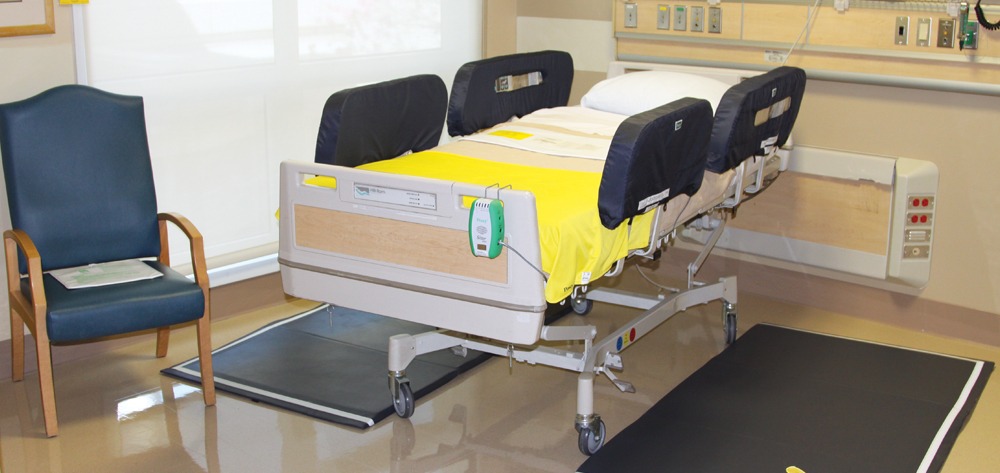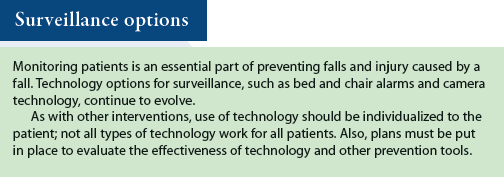Falls pose a major public health problem around the world. In the United States, unintentional falls occur in all age groups. Such falls are the leading cause of nonfatal injuries treated in emergency departments (EDs) among all age groups except ages 10-14 and 15-24, for whom these falls are the second leading cause.
Commonly called “never events,” injurious falls can cause significant morbidity and mortality. Some 3% to 20% of inpatients fall at least once during their hospital stay. Also, adults ages 65 and older account for 70% of inpatient bed days in hospitals; advanced age is an independent risk factor for falls.
We need to accept that all patients in our care are at risk for falling. For this reason, nurses who practice in any setting and care for patients of any age should be actively involved in patient safety and fall-prevention awareness and interventions. This article summarizes recommendations regarding key fall precautions for patients under the direct care of registered nurses (RNs) in acute or long-term settings. Key precautions fall into these categories:
- Follow the nursing process.
- Reduce the risk of falls.
- Protect patients from injury if a fall occurs.
Follow the nursing process
Every RN learns about the nursing process—assessment, diagnosis, outcome identification, planning, implementation, and evaluation. You must carry out all steps of this process for each patient to ensure that you’ve assessed fall risk factors and that the assessment leads to a diagnosis. Communication and collaboration among interdisciplinary team members are crucial.
The nursing process and nursing judgment—not electronic records with templated checkbox notes—should drive patient care. A primary characteristic of nursing practice is that it’s individualized for each patient. Unless you complete all the nursing process steps, individualized fall-prevention plans of care aren’t established with the patient, caregivers, and interdisciplinary team.
Reduce the risk of falls
The three main types of falls are accidental falls, anticipated physiologic falls, and unanticipated physiologic falls. This article focuses on the first two. (For more information on preventing falls, including unanticipated physiologic falls, see “Assessing your patients’ risk for falling” in this special section.)
Reducing fall risk also includes surveillance. (See Surveillance options.)
Reducing accidental fall risk
Accidental falls can result from an unsafe environment or environmental risk factors. To reduce the risk of these falls, maintain a constant awareness of environmental safety and take the following actions:
- Eliminate slipping and tripping hazards.
- Keep the bed at the proper height during transfer and when the patient rises to a standing position.
- Don’t keep the bed in a low position at all times.
- Check chairs, toilets, and safety grab bars for potential safety problems.
- Use proper room lighting.
- Make sure the patient wears proper footwear (not just nonskid socks).
Also, conducting environmental rounds helps nurses identify and modify environmental fall and injury risks. Such rounding provides a structured method for recording when and where risks exist, assigning responsibility to correct them, establishing resolution dates, and setting a follow-up date for resolution.
Reducing anticipated physiologic fall risk
Anticipated physiologic falls can stem from known intrinsic or extrinsic risk factors.
- Intrinsic risk factors include impaired vision, gait, or balance; lower-extremity sensory neuropathy; orthostatic hypotension; and confusion.
- Extrinsic risk factors include certain medications and mobility aids, such as canes and walkers. To identify extrinsic risk factors, perform a comprehensive multifactorial assessment. Evidence supports the use of multifactorial fall-prevention programs for reducing falls and injuries in acute-care settings.
To reduce the risk of anticipated physiologic falls, use interventions tailored to the patient’s identified risk factors. For example, if the patient has elimination problems, implement anticipated toileting; for a patient with sleep deficits, suggest alternative sleep hygiene methods (listening to talking books or soft music or getting a backrub) rather than sleep medications. If the patient has impaired gait or balance, keep mobility aids within reach and provide a referral to rehabilitation services.
Protect patients from injury if a fall occurs
Recent fall-prevention toolkits have focused on assessment and treatment of modifiable fall and injury risks, along with population-specific approaches. In other words, you should assess all patients (especially those older than age 65) for fall injury risk and history.
Be aware that interventions meant to protect patients from injury are separate and distinct from those used to prevent falls. For instance, if the patient has a history of a hip fracture, surveillance practices (for example, rounding), protective equipment (such as floor mats and hip protectors), and possibly technology (for example, video surveillance and chair alarms) should be used, regardless of the patient’s score on a fall-risk screening tool. Strategies to reduce trauma and injury, such as using floor mats and hip protectors and eliminating sharp edges, have been integrated into toolkits and practice for older adults for more than 10 years. Helpful toolkits are available from multiple agencies, such as the Department of Veterans Affairs, Institute for Healthcare Improvement, Institute for Clinical Systems Improvement, Agency for Healthcare Research and Quality, and the Minnesota Hospital Association.
As nurses, we can significantly reduce the risk of falls and decrease the rates of patient falls and injuries caused by falls by using our clinical judgment and expertise, individualizing each patient’s care, and broadening fall prevention to include injury risk and protection from injury.
Patricia Quigley is associate director for the VISN 8 Patient Safety Center of Inquiry at the James A. Haley Veterans’ Hospital in Tampa, Florida.
Selected references
Agency for Healthcare Research and Quality. Preventing falls in hospitals: a toolkit for improving quality of care. 2013. https://www.ahrq.gov/professionals/systems/hospital/fallpxtoolkit/index.html
American Nurses Association. Nursing: Scope and Standards of Practice. 2nd ed. Silver Spring, MD: Author; 2010.
Boushon B, Nielsen G, Quigley P, et al. Transforming Care at the Bedside How-to Guide: Reducing Patient Injuries from Falls. Cambridge, MA: Institute for Healthcare Improvement; 2012.https://www.ihi.org/resources/Pages/Tools/TCABHowToGuideReducingPatientInjuriesfromFalls.aspx
Degelau J, Belz M, Bungum L, et al.; Institute for Clinical Systems Improvement (ICSI). Health Care Protocol. Prevention of Falls (Acute Care). Bloomington, MN: ISCI; 2012.
Dykes PC, Carroll DL, Hurley A, et al. Fall prevention in acute care hospitals: a randomized trial. JAMA. 2001;304(17):1912-8.
Morse JM. Preventing Patient Falls: Establishing A Fall Intervention Program. 2nd ed. Thousand Oaks, CA; Springer Publishing Co.; 2008.
National Center for Health Statistics. 10 leading causes of injury deaths by age group highlighting unintentional injury deaths, United States—2013. 2013. www.cdc.gov/injury/images/lccharts/leading_causes_of_injury_deaths_highlighting_unintentional_injury_2013-a.gif
National Institute for Health and Care Excellence. Falls: Assessment and prevention of falls in older people. Guideline 161. 2013. www.nice.org.uk/guidance/cg161/chapter/ 1-recommendations.
Oliver D, Healey F, Haines TP. Falls and fall-related injuries in hospitals. Clin Geriatr Med. 2010;26(4):645-92.
Shekelle PG, Wachter RM, Pronovost PJ, et al. Making health care safer II: an updated critical analysis of the evidence for patient safety practices. Evid Rep Technol Assess (Full Rep). 2013;(211):1-945. www.ahrq.gov/research/findings/evidence-based-reports/ptsafetyuptp.html
Spoelstra SL, Given BA, Given CW. Fall prevention in hospitals: an integrative review. Clin Nurs Res. 2012;21(1):92-112.
U.S. Department of Veterans Affairs. VA National Center for Patient Safety. Falls Toolkit. 2014. www.patientsafety.va.gov/professionals/onthejob/falls.asp
Williams T, Szekendi M, Thomas S. An analysis of patient falls and fall prevention programs across academic medical centers. J Nurs Care Qual. 2014;29(1):19-29.

